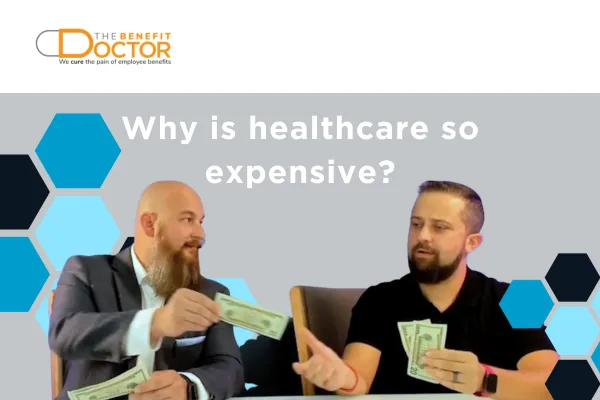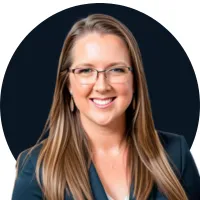A lot.
How many times have you seen someone go through a major health event, with "good insurance" and had to pay a big chunk of money out of their own pocket. Then they still get more bills in the mail months (maybe even years) later.
Why?
Shouldn't insurance cover everything? Why even have it in the first place?
We believe that it all comes down to two things.
First, how your benefits get built matters. It directly impacts you and your team, not just with the monthly costs, but when you actually have to use the benefits.
Second, you take this extremely expensive and complicated thing, put it into a few pages of a PDF or website, then expect people to make a wise choice on what plan is best for their situation, to find the best care for the lowest cost, and to top it all off expect them to keep everything "in network".
Because they were built to
Help them find the best doctor for what they need
Give them help covering out of pocket costs when health events happen
Have a dis-appearing deductible
Make sure they could still pay their regular bills when a major health event happens
Not Only Is It POSSIBLE.
It's Being Done.
A lot.
How many times have you seen someone go through a major health event, with "good insurance" and had to pay a big chunk of money out of their own pocket. Then they still get more bills in the mail months (maybe even years) later.
Why?
Shouldn't insurance cover everything?
Why even have it in the first place?
We believe that it all comes down to two things.
First, how your benefits get built matters.
It directly impacts you and your team, not just with the monthly costs, but when you actually have to use the benefits.
Second, you take this extremely expensive and complicated thing, put it into a few pages of a PDF or website, then expect people to make a wise choice on what plan is best for their situation, to find the best care for the lowest cost, and to top it all off expect them to keep everything "in network".
Because they were built to
Help them find the best doctor for what they need
Give them help covering out of pocket costs when health events happen
Have a dis-appearing deductible
Make sure they could still pay their regular bills when a major health event happens
YOU DESERVE THE BEST...
THAT'S WHY OUR PROCESS IS DESIGNED WITH YOU IN MIND.
Stories & More

Why Is Healthcare So Expensive?
“To understand why costs continue to go up you have to understand the MLR” - Anthony Pacheco
What's the MLR:
MLR stands for Medical Loss Ratio, it was introduced into legislation in 2010 as part of the Affordable Care Act. "At its most basic, a MLR measures the share of health care premium dollars spent on medical benefits, as opposed to company expenses such as overhead or profits. For example, if an insurer collects $100,000 in premiums and spends $85,000 on medical care, the MLR is 85%. ... The ACA requires an annual, minimum 80% MLR for individual and small group insurance plans, and an annual, minimum 85% MLR for large group plans."
Sounds easy enough right? So why didn't it work the way they intended it to? Watch this video to learn more and we'll continue down below:
Key Takeaways
1. Theories and Results Are Two Different Things
The requirement to spend 80% of money coming in to pay claims does not end up equalling better coverage for those who are paying into the system. It has resulted in costs continuing to go up as the profits for large insurance companies are based on getting the 20% of higher and higher premiums.
2. This Will Not Change
Costs will continue to increase so long as people continue to use the large (publicly traded) insurance companies, here's why... they are not looking to do what's best, cost wise, for the people paying the premiums. Their duty is to do what's best for their shareholders. That is why they will never align with the same goals as the people paying the premiums. (It's what we call having mis-aligned incentives. Your goal is not the same as their goal.)
3. To The Crazy Ones
Now let's say you want to find a way to make the goals/outcomes/incentives align... this is where people will start to call you crazy. Even though solutions have been around for since 1974, many people don't realize that these options exist. Or, they've heard horror stories about them. Yep, we're talking about "self-funding" the benefits. Let's use a sports analogy to help simplify why you may want to look for a "crazy" solution. Do you want to play offense (being proactive) with your benefits instead of always playing defense (being reactive)? Then head to the checklist below to see if you're ready to start.
The Crazy Ones Checklist:
A checklist to see if you are ready to start looking for alternatives where you can play offense with your benefits instead of playing defense all the time.
Are you tired of rate increases every year with no control of why, or how the increases happen?
Do you wish your employees would actually to go to the doctor when they need to... instead of avoiding it because they don't want to pay the out of pocket costs (or can't afford to)?
Want a long term strategy that gives you transparency into your benefits and allows you to create a plan ahead of time?
Are you facing hard questions like, keeping insurance in place vs. firing people to be able to afford it?
If you checked at least one of the boxes above then we should talk. You can contact us to have a conversation about your options.
About Emily Evans

Emily has been in the benefits industry since Aug. 2011. Her journey started as an independent agent, but in 2019 she realized that her clients needed more from her.
She created her brokerage company Emily Evans Consulting LLC at that time. The struggles of seeing her clients get the short end of the stick time after time from the large insurance companies made her continue looking for a better solution.
In 2021 Emily banded together with a group of likeminded individuals to help start The Benefit Doctor. Our unique way of building, educating, enrolling, and servicing clients is continually reviewed to ensure the best partners for our clients.
About Emily Evans
Emily has been in the benefits industry since Aug. 2011. Her journey started as an independent agent, but in 2019 she realized that her clients needed more from her.
She created her brokerage company Emily Evans Consulting LLC at that time. The struggles of seeing her clients get the short end of the stick time after time from the large insurance companies made her continue looking for a better solution.
In 2021 Emily banded together with a group of likeminded individuals to help start The Benefit Doctor. Our unique way of building, educating, enrolling, and servicing clients is continually reviewed to ensure the best partners for our clients.
We service clients nationwide with our team of Benefit Doctors.
Emily specializes in the states of Arizona, Florida, and Texas. (All the places where her family lives. 😁)
Her focus is on clients from 10 employees up to 500 employees.



